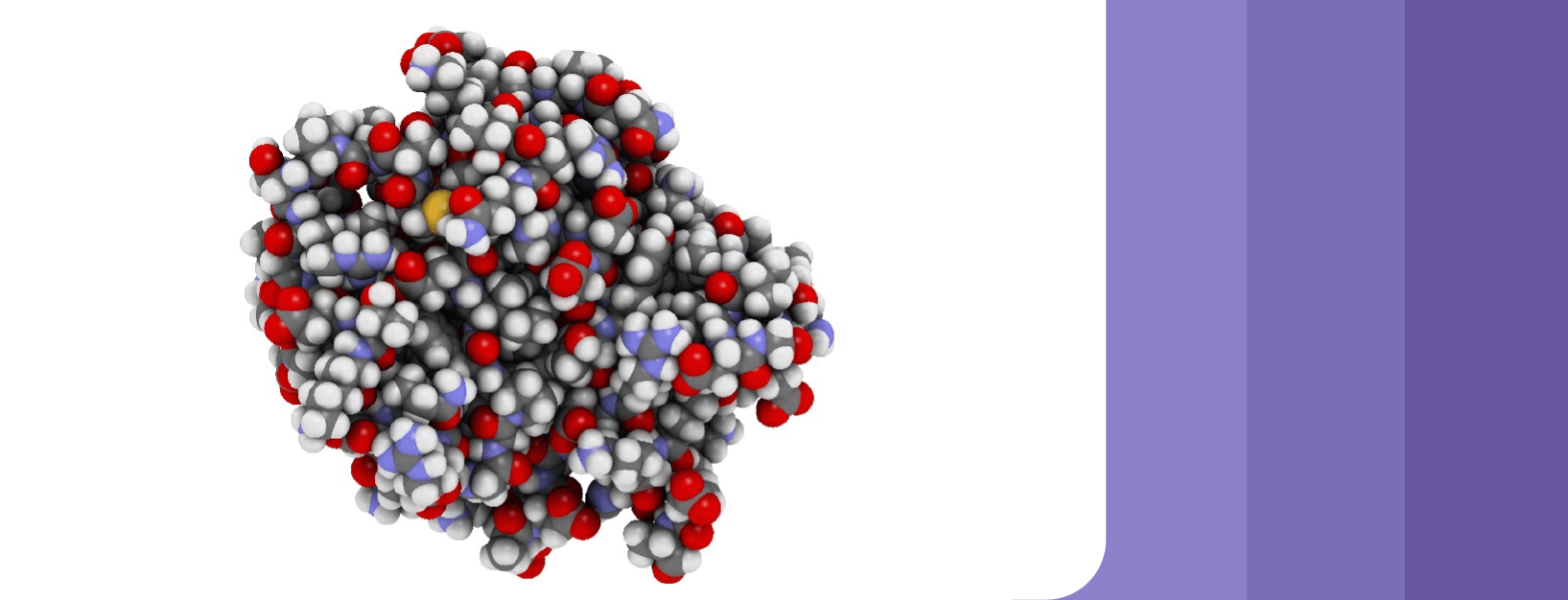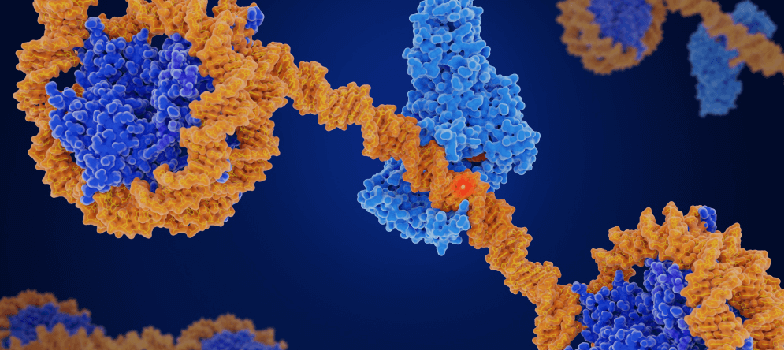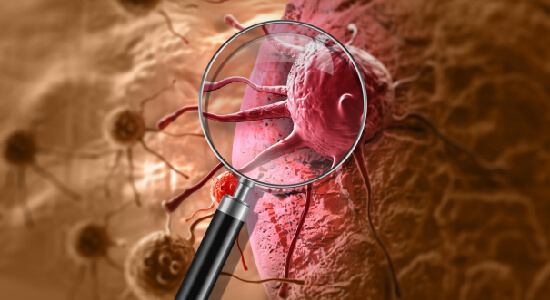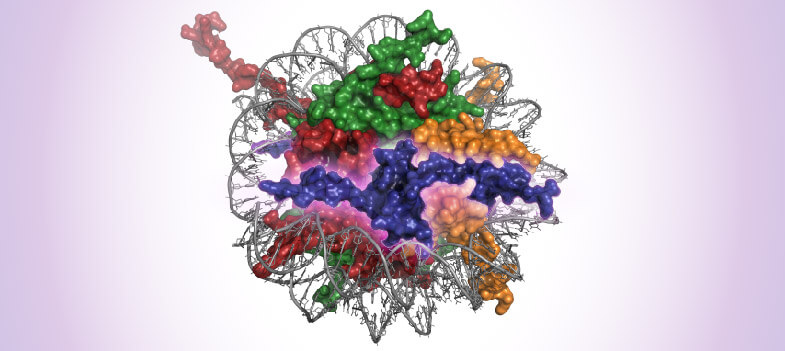<< Back to MOTIFvations Blog Home Page
Strategies for KRAS Research and Drug Discovery

By Michelle Tetreault Carlson, Ph.D.
March 8, 2023
Table of Contents:
Introduction
RAS is a subfamily of small GTPase proteins, expressed in all animal cells and first discovered in 1982. RAS proteins, including HRAS, KRAS, and NRAS, can each contain single amino acid point mutations, which have been found to be associated with and contribute to tumorigenesis in 20-30% of all human cancers. It’s not surprising then, that targeting mutant RAS is of intense interest for cancer researchers. All three major isoforms of RAS proteins: KRAS, HRAS, and NRAS are implicated in cancer.
While all three of these express cancer driving mutations, they differ in their occurrence in cancer types. NRAS mutations drive 23% of melanoma cancers, whereas HRAS mutations are found in 5% of bladder and thyroid cancers. Of the three RAS isoforms, KRAS is by far the most frequently mutated, with this oncogene accounting for about 80% of all RAS driven cancers. KRAS mutations are especially high in some of the deadliest cancers, present in 77% of pancreatic, 43% of colorectal, and 27% of non-small cell lung cancers. These cancers are often only found in their late stages and even when found early, they can be difficult to treat. Any therapies which could effectively target KRAS driven cancer would be immensely important, with the potential to save thousands of lives. Consequently, current research has primarily been focused on targeting KRAS isoform-driven cancers.
KRAS Mutations and Oncogenesis
RAS proteins are in simplest terms binary molecular switches, toggling between an inactive GDP bound state and an active GTP bound state. RAS sits at the cytoplasmic side of the cell membrane and when activated, binds to, and activates Raf proteins. This results in the activation of many other downstream proteins and transcription factors involved in cell division, proliferation, and survival. The switch from GDP to GTP is accelerated by Guanine nucleotide exchange factors (GEF) like Son of Sevenless (SOS). Conversely, the switch back to GDP is accelerated by GTPase activating proteins (GAPS) which hydrolyze GTP to GDP.
Cancer causing KRAS mutations throw this normally tightly balanced system out of order. The most common cancer promoting mutations in KRAS, occur at the G12 residue, which is in the P-loop region of the protein. The P-loop regulates critical interactions between KRAS and the phosphate groups of GTP and GDP. Oncogenic missense mutations at G12 bring about an increase in GTP binding, KRAS activation, and downstream signaling. The result enables tumors cells to more easily proliferate and metastasize.
Targeting Wayward KRAS
Any therapy which puts the brakes on KRAS activity should in theory reduce the ability of tumor cells to wreak havoc. However, KRAS activity is required for normal physiological processes too, so treatments which blanketly block active KRAS will likely affect normal pathways in both healthy cells and cancer cells. That being the case, most pharmaceutical companies are looking for drugs which selectively target KRAS mutants to avoid deleterious secondary effects.
Developing drugs which target mutant KRAS only is made complex by the wide distribution of different KRAS mutations. There are at least nine different mutations that can occur at the G12 residue, and they favor different tissue types. In pancreatic adenocarcinoma (PDAC), mutant expression is dominated by G12D, G12V, and G12R. Non-small cell lung cancer most commonly contains the G12C mutation, but may also contain G12V and G12D. Colorectal cancer most often contains G12D and G12V, but sometimes G12S.
Another obstacle in developing these types of drugs has been the shape of the KRAS protein itself, which is relatively smooth and round like a ball. In fact, until the last decade, RAS was thought to be “undruggable” due to a lack of structural pockets for drug interaction and the picomolar affinity for GTP/GDP. It was not until 2013 that Kevan Shokat’s team at UCSF successfully reported the development of compounds that irreversibly bound to KRAS G12C in the GDP-bound state, obstructing activation by SOS and impairing binding with RAF (Ostrem et al., Nature. 2013). These compounds relied on the mutant cysteine for binding and so did not affect wild-type protein. In addition, crystallographic studies revealed the formation of a binding pocket not seen earlier in earlier structures. Binding of inhibitors to KRAS G12C disrupted the binding pocket and subsequently shifted the affinity of KRAS to prefer GDP over GTP. These discoveries paved the way for renewed drug discovery efforts which targeted mutant KRAS.
KRAS Inhibitors Approved for Use Today
Amgen was the first to successfully bring one of the many resulting new KRAS inhibitors to market. In May 2021, the US Food and Drug Administration approved the KRAS G12C inhibitor Lumakras (sotorasib: AMG510) for previously treated patients with metastatic non-small cell lung cancer (NSCLC) expressing the KRAS G12C mutation. It was reported in April 2022 that patients treated with Lumakras had a two-year overall survival rate of 32.5%, an improvement over previous therapies. Long-term treatment with Lumakras was well tolerated, with mild and manageable toxicities. Unfortunately, most patients did not respond, due to intrinsic or acquired resistance to the drug.
Another KRAS G12C inhibitor, adagrasib: MRTX849, from Mirati may soon be available to patients. This inhibitor was chemically derived from AMG510 and is similar in structure. A drug application for Adagrasib was accepted by the USFDA in February 2022 for treatment of patients with previously treated KRAS G12C NSCLC. Again, drug resistance is an ongoing issue in patients. However, new therapeutic strategies are being tested, for example combining KRAS G12C inhibitors with other compounds to increase efficacy. There are many other KRAS G12C inhibitors in development as well, by companies including Johnson & Johnson, LOXO Oncology, Boehringer Ingelheim, Revolution Medicines, and Sanofi.
As mentioned earlier, while the KRAS G12C mutation is common in non-small cell lung cancer, it is not often found in pancreatic cancer and colorectal cancer, where the KRAS G12D and G12V mutations are far more common (Parikh et al., J Hematol Oncol. 2022). For these mutations, a different strategy is required as aspartic acid and valine are less reactive than cysteine. Also, unlike KRAS G12C these mutants do not spend as much time in the GDP state, which is how inhibitors of KRAS G12C are believed to block activation by SOS. Recently, there have been several publications showing that other KRAS mutant proteins, like KRAS G12D can also be targeted by inhibitors, despite these differences. Research out of Hubei University in and Tsinghua University were able to design a series of potent KRAS G12D inhibitors that can form a salt bridge with the KRAS As12 residue and that bind both GDP and GTP bound KRAS G12D equally well. Mirati has published the discovery of a noncovalent and potent selective inhibitor MRTX1133 of KRAS G12D (Wang et al., J Med Chem. 2022). Furthermore, MRTX1133 was able to reduce active KRAS G12D in xenograft pancreatic mouse tumor models. In late 2022, Kevan Shokat’s lab described in more mechanistic detail how inhibitors such as MRTX1133 can inhibit KRAS noncovalently, and how inhibition does not necessarily depend on the GDP state of KRAS (Vasta et al., Nat Chem Biol. 2022). These exciting new results point to new therapeutic opportunities for cancers driven by other KRAS mutations.
Other Strategies - Vaccines
In addition to selective inhibitors, there are other strategies being investigated for targeting mutant KRAS. An mRNA vaccine developed by Moderna, mRNA-5671, is one that is already in clinical trials. The mRNA, enclosed in lipid nanoparticles, codes for a cocktail of peptides containing the most common KRAS mutations, with the idea of prompting the immune system to produce antibodies against those mutant proteins. Along the same lines, another company, Targovax, has created two anti-cancer vaccines TG01 and TG02, which contain collections of mutated KRAS peptides. These were developed to be injected into patients with KRAS driven cancers along with QS-21, a compound that boosts immune reactions so that again the body will destroy the mutant protein.
Other Strategies - PROTACS
PROteolysis TArgeting Chimeras (PROTACs), which have been in development for 20 years, are a potential method for selectively destroying a targeted protein in the body. PROTACs are small molecules composed of two active domains and a linker, designed to take advantage of the cell’s ubiquitin proteosome system to bring together a target protein and a ligase so that the protein is degraded. The first PROTAC for KRAS, LC-2, was designed by the Crews lab at Yale University (Bond et al., ACS Cent Sci. 2020) to be specific for KRAS G12C.
While targeting mutant KRAS directly seems to be the preferred method to halting these cancers, as it’s most likely to avoid harming healthy cells, there are some indirect methods being explored as well. Since GTPase activity is crucial for KRAS function, inhibiting GDP-GTP exchange should also block KRAS activity. SOS1 (Son of Sevenless 1) is the main guanosine nucleotide exchange factor (GEF) for KRAS, increasing the nucleotide exchange rate of GDP for GTP. Therefore, inhibiting SOS1 should also down-regulate active KRAS in tumor cells. Several small molecule inhibitors of SOS1 have been developed and show efficacy in decreasing KRAS activation. Among the most well-known of these are BAY-293 and BI-1701963. These types of drugs may be most effective when combined with other drugs. For example, when BAY-293 was used alone, it had weak physiological effects on KRAS mutant proteins. However, in combination with selective KRAS mutant inhibitors, it showed a synergistic growth-inhibitory effect on tumor cells (Plangger et al., Discov Oncol. 2022). Another compound, BI-1701963 is being tested both alone and in combination with other drugs for patients with solid tumors and mutations. Revolution Medicines and Sanofi are co-developing a potent and selective inhibitor of a different protein involved in KRAS GDP-GTP exchange, SHP2. The goal of targeting SHP2 is the same as SOS inhibitors: inhibiting nucleotide exchange and therefore, Ras GTPase activity. The compound called RMC-4630 is part of a multi-cohort Phase 1/2 clinical program, both a monotherapy and in combination with the kinase inhibitor, cobimetinib.
Summary
RAS is one of the most common oncogenes, responsible for somewhere between 20-30% of all human cancers. Of all RAS driven cancers, KRAS is responsible for most of these, driving 80% of tumorigenesis. These include some of the most dangerous cancers such as CRC, NSCLCC, and PDAC. Hence current research has mostly focused on targeting KRAS mutants. Up until about a decade ago, there wasn’t much we could do to directly inhibit mutant KRAS, due to lack of awareness of possible drug pockets and the difficulty with small molecules competing with GTP/GDP which bind extremely tightly to KRAS. But since then, new understandings in the KRAS activation mechanism have enabled the development of a large pipeline of potential drugs which may change the way these dangerous cancers are treated. The possibilities for changing the lives of many of those affected by cancer are vast.
About the author

Michelle Tetreault Carlson, Ph.D.
Michelle’s interest in science was first spurred by the starry skies above her rural farm in upstate New York State, leading her to pursue a B.S. in physics. She was originally interested in astrophysics when entering the University of California, San Diego, but transitioned towards the more practical pursuit of biology earning her Ph.D. in Biophysics, studying photosynthetic proteins. Michelle’s postdoctoral research on retinal ion channels, took her further towards biology, ultimately leading to a career in the biotech industry. She enjoys chatting with scientists about their projects and interacts with them both as a Technical Support Scientist and Product Manager for Active Motif’s DNA Methylation products.
Michelle is a mother of 4 kids and 2 cats, and her hobbies include puzzles (the sign of a patient and logical mind), cooking, and pondering the human condition.
Contact Michelle with any questions at [email protected]
Related Articles
Undruggable No More – Advances for Targeting Mutant Ras Proteins and Cancer
May 17, 2022
While they may not in a song, the Ras family of proteins do take a lead in several crucial physiological processes, across species and disease states. Volumes of work have written on Ras and continues today - to decipher RAS function, and to pursue understanding of Ras mutations for diagnostic and prognostic tools. In this article, we look at RAS research strategies, key articles, and future directions in this exciting field.
Read More
DNA Methylation for Predicting Prostate Cancer: Where Do We Stand?
December 13, 2022
Some say that Epigenetics touches everything. The marriage between DNA methylation, one of the earliest and most studied of epigenetic mechanisms, and its potential to be a powerful biomarker for disease is exciting and promising. In this overview, we look at prostate cancer research in particular - where we stand in this regard, and also a “new” biomarker associated with voltage-dependent calcium channels!
Read More
PROTAC-mediated Targeted Protein Degradation in Cancer: PARP, EGFR, and SMARCAs in Focus
April 13, 2022
Proteolysis-Targeting Chimera (PROTAC) protein degraders are the emerging alternative to small molecule-based targeting. Here we look at key protein targets and discuss how PROTAC-mediated targeted protein degradation represents a promising new approach to cancer treatment.
Read More
Oncohistones: Histone Mutations & Their Oncogenic Effects
June 24, 2021
Oncohistones are amino acid mutations in Nucleosomes shown to have strong correlation to many types of cancers. The cancer-type specificity of oncohistones may facilitate targeted therapy, while limiting the side effects that occur with chemotherapy. Methods to detect these mutations could also help in diagnostic and prognostic applications in personalized medicine.
Read More
<< Back to MOTIFvations Blog Home Page









